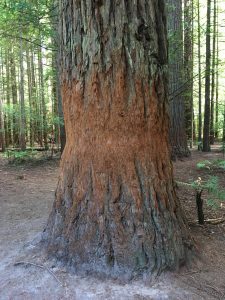The Redwoods of Rotorua in New Zealand are arguably the most substantial and therefore the most important stand of Redwood trees outside of those on the Pacific coast of North America. Visit them you must, look but don’t touch.

The Redwoods of Rotorua
Over three and a half million people visit Rotorua every year. Not all of them pop out to Whakarewarewa Forest and touch a Redwood tree, but a lot do, and all of those millions of good intended touches are doing damage.
It’s hard to comprehend that something the size of a massive Californian Redwood (Sequoia sempervirens) could be so fragile that it could be damaged because of a simple touch – but that is exactly what is happening. So, to all of you tree huggers, and bark touchers – stop it, leave the trees alone.
Bark refers to all the tissues on the outside of the vascular cambium. We normally think of bark as dead, but not all of it is. There is inner bark and outer bark, and depending on how much detail you what, or where you draw the line, there are various layers of bark in-between.
Keeping it relatively simple, in plants with secondary thickening the inner of the inner bark consists of actively dividing tissue called the phelloderm. Phelloderm is alive, and this is the important bit (for this story at least).
Cells grow inwards from the phelloderm and cells develop outwards from it, those cells that develop outwards go on to form cork, or what most of us think of as bark – when we think of bark.
Phelloderm sits, blended in with outer layers of the secondary phloem, and phloem if you recall is the vascular tissue primarily involved with moving products of photosynthesis down and around the plant.
In our Redwoods (a plant known for having extremely thick bark) all this touching by millions and millions of well-meaning hands is slowly but surely removing the tissue that develops outwards from phelloderm – it is removing the dead bark and will eventually expose living tissue. Slowly but surely the cells are being removed and slowly but surely the phloem is getting closer and closer to being exposed; when the phloem becomes exposed… slowly but surely the tree will decline.
It’s hard to comprehend that something the size of a massive Californian Redwood could be so fragile that it could be damaged because of being touched – but damage is occurring. If you get a chance to visit Rotorua, do pop out to Whakarewarewa Forest and see these beautiful trees, it is well worth the effort; but look don’t touch.
0 Comments